Positive Leadership Skills for Employee Performance and Well-being
VerifiedAdded on 2021/01/01
|7
|1851
|356
Presentation
AI Summary
This presentation delves into the concept of positive leadership, emphasizing its role in enhancing employee performance and well-being within an organization. It defines leadership and highlights the characteristics of a good leader, with a particular focus on communication skills. The presentation explores strategies for improving employee well-being and productivity, including equipping teams with the right tools (time tracking, collaboration, and communication apps) and implementing various skill development exercises such as training, orientation programs, team-building activities, and job changes. The conclusion underscores the importance of leaders in guiding employees, fostering effective communication, and motivating them to achieve organizational goals. The presentation provides a comprehensive overview of the key aspects of positive leadership and its practical applications in the workplace.
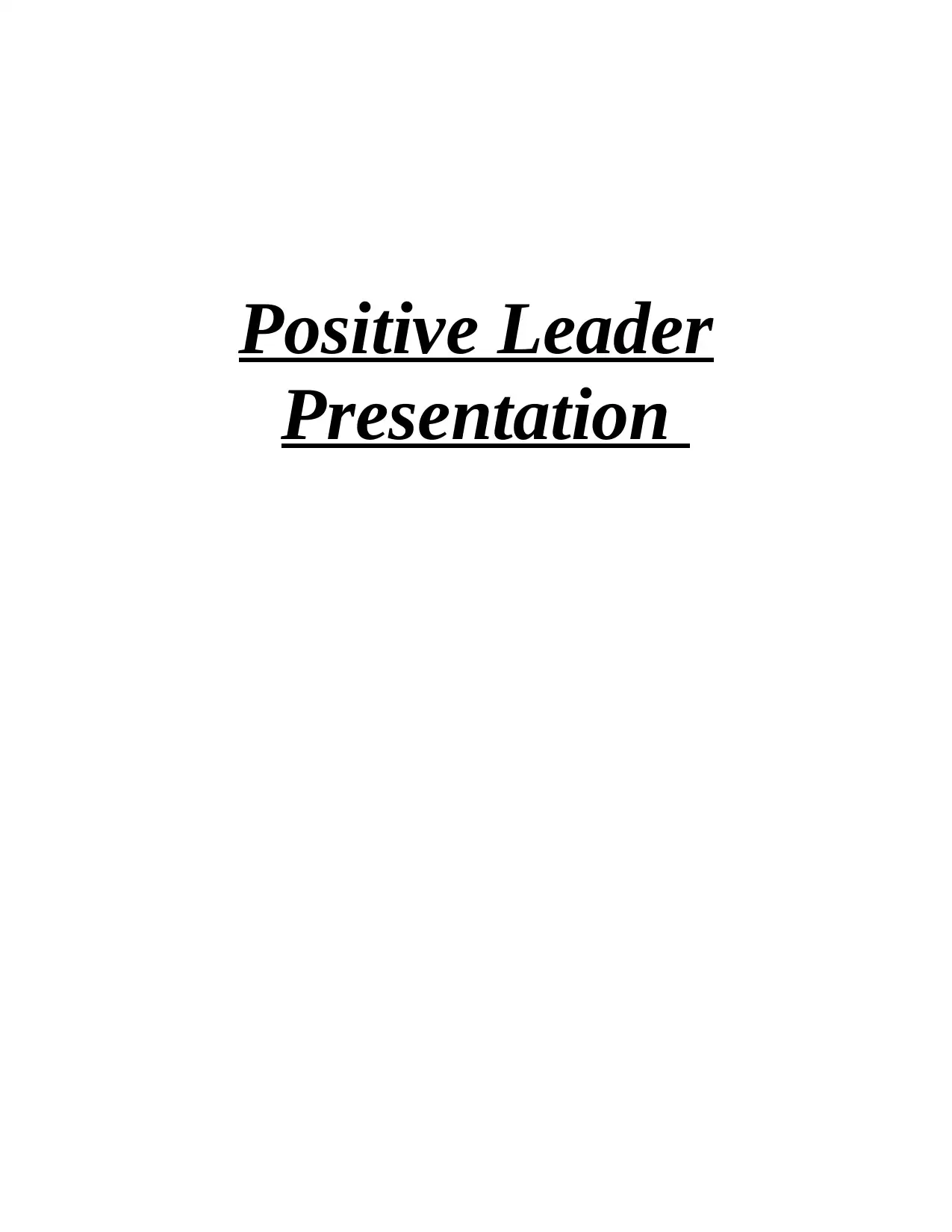
Positive Leader
Presentation
Presentation
Paraphrase This Document
Need a fresh take? Get an instant paraphrase of this document with our AI Paraphraser
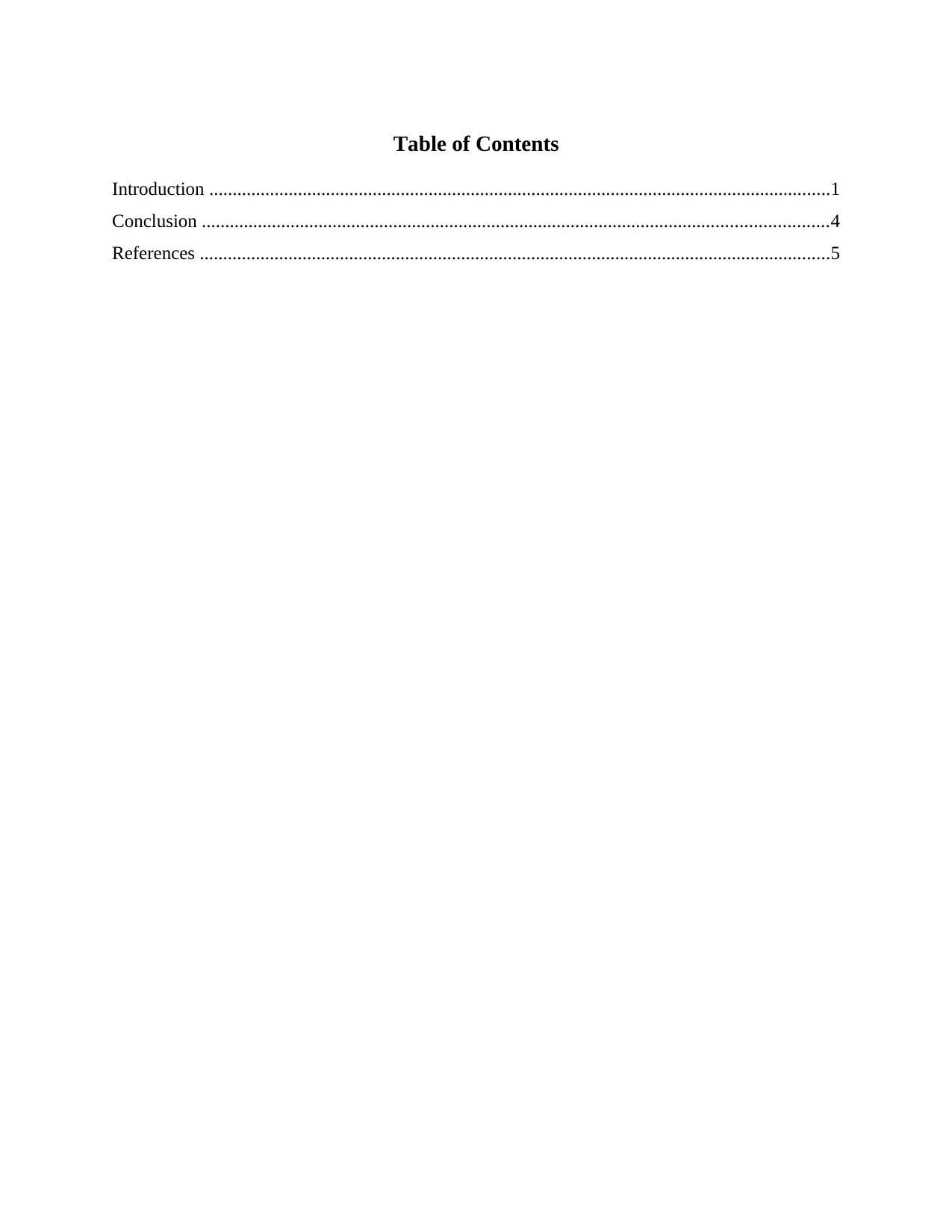
Table of Contents
Introduction .....................................................................................................................................1
Conclusion ......................................................................................................................................4
References .......................................................................................................................................5
Introduction .....................................................................................................................................1
Conclusion ......................................................................................................................................4
References .......................................................................................................................................5
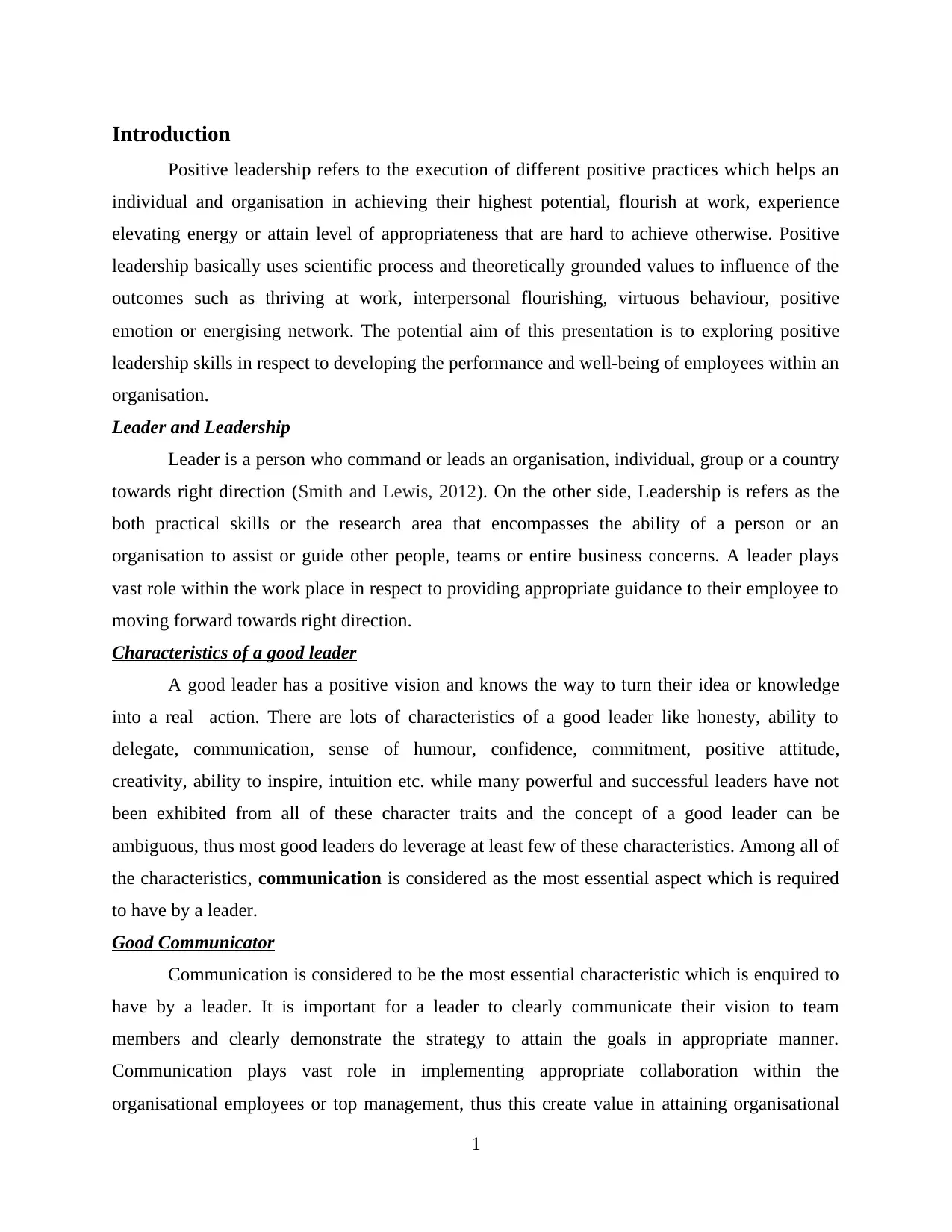
Introduction
Positive leadership refers to the execution of different positive practices which helps an
individual and organisation in achieving their highest potential, flourish at work, experience
elevating energy or attain level of appropriateness that are hard to achieve otherwise. Positive
leadership basically uses scientific process and theoretically grounded values to influence of the
outcomes such as thriving at work, interpersonal flourishing, virtuous behaviour, positive
emotion or energising network. The potential aim of this presentation is to exploring positive
leadership skills in respect to developing the performance and well-being of employees within an
organisation.
Leader and Leadership
Leader is a person who command or leads an organisation, individual, group or a country
towards right direction (Smith and Lewis, 2012). On the other side, Leadership is refers as the
both practical skills or the research area that encompasses the ability of a person or an
organisation to assist or guide other people, teams or entire business concerns. A leader plays
vast role within the work place in respect to providing appropriate guidance to their employee to
moving forward towards right direction.
Characteristics of a good leader
A good leader has a positive vision and knows the way to turn their idea or knowledge
into a real action. There are lots of characteristics of a good leader like honesty, ability to
delegate, communication, sense of humour, confidence, commitment, positive attitude,
creativity, ability to inspire, intuition etc. while many powerful and successful leaders have not
been exhibited from all of these character traits and the concept of a good leader can be
ambiguous, thus most good leaders do leverage at least few of these characteristics. Among all of
the characteristics, communication is considered as the most essential aspect which is required
to have by a leader.
Good Communicator
Communication is considered to be the most essential characteristic which is enquired to
have by a leader. It is important for a leader to clearly communicate their vision to team
members and clearly demonstrate the strategy to attain the goals in appropriate manner.
Communication plays vast role in implementing appropriate collaboration within the
organisational employees or top management, thus this create value in attaining organisational
1
Positive leadership refers to the execution of different positive practices which helps an
individual and organisation in achieving their highest potential, flourish at work, experience
elevating energy or attain level of appropriateness that are hard to achieve otherwise. Positive
leadership basically uses scientific process and theoretically grounded values to influence of the
outcomes such as thriving at work, interpersonal flourishing, virtuous behaviour, positive
emotion or energising network. The potential aim of this presentation is to exploring positive
leadership skills in respect to developing the performance and well-being of employees within an
organisation.
Leader and Leadership
Leader is a person who command or leads an organisation, individual, group or a country
towards right direction (Smith and Lewis, 2012). On the other side, Leadership is refers as the
both practical skills or the research area that encompasses the ability of a person or an
organisation to assist or guide other people, teams or entire business concerns. A leader plays
vast role within the work place in respect to providing appropriate guidance to their employee to
moving forward towards right direction.
Characteristics of a good leader
A good leader has a positive vision and knows the way to turn their idea or knowledge
into a real action. There are lots of characteristics of a good leader like honesty, ability to
delegate, communication, sense of humour, confidence, commitment, positive attitude,
creativity, ability to inspire, intuition etc. while many powerful and successful leaders have not
been exhibited from all of these character traits and the concept of a good leader can be
ambiguous, thus most good leaders do leverage at least few of these characteristics. Among all of
the characteristics, communication is considered as the most essential aspect which is required
to have by a leader.
Good Communicator
Communication is considered to be the most essential characteristic which is enquired to
have by a leader. It is important for a leader to clearly communicate their vision to team
members and clearly demonstrate the strategy to attain the goals in appropriate manner.
Communication plays vast role in implementing appropriate collaboration within the
organisational employees or top management, thus this create value in attaining organisational
1
⊘ This is a preview!⊘
Do you want full access?
Subscribe today to unlock all pages.

Trusted by 1+ million students worldwide
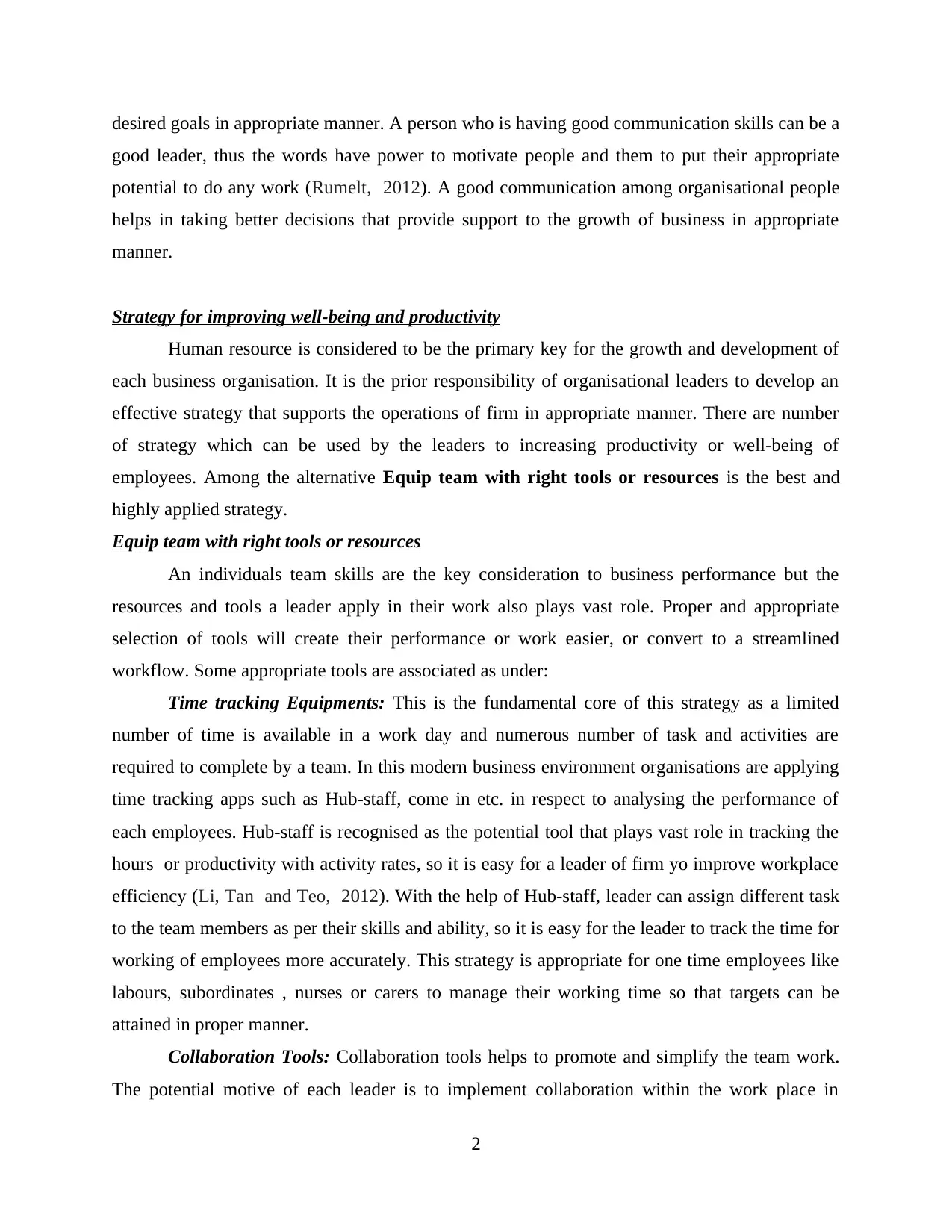
desired goals in appropriate manner. A person who is having good communication skills can be a
good leader, thus the words have power to motivate people and them to put their appropriate
potential to do any work (Rumelt, 2012). A good communication among organisational people
helps in taking better decisions that provide support to the growth of business in appropriate
manner.
Strategy for improving well-being and productivity
Human resource is considered to be the primary key for the growth and development of
each business organisation. It is the prior responsibility of organisational leaders to develop an
effective strategy that supports the operations of firm in appropriate manner. There are number
of strategy which can be used by the leaders to increasing productivity or well-being of
employees. Among the alternative Equip team with right tools or resources is the best and
highly applied strategy.
Equip team with right tools or resources
An individuals team skills are the key consideration to business performance but the
resources and tools a leader apply in their work also plays vast role. Proper and appropriate
selection of tools will create their performance or work easier, or convert to a streamlined
workflow. Some appropriate tools are associated as under:
Time tracking Equipments: This is the fundamental core of this strategy as a limited
number of time is available in a work day and numerous number of task and activities are
required to complete by a team. In this modern business environment organisations are applying
time tracking apps such as Hub-staff, come in etc. in respect to analysing the performance of
each employees. Hub-staff is recognised as the potential tool that plays vast role in tracking the
hours or productivity with activity rates, so it is easy for a leader of firm yo improve workplace
efficiency (Li, Tan and Teo, 2012). With the help of Hub-staff, leader can assign different task
to the team members as per their skills and ability, so it is easy for the leader to track the time for
working of employees more accurately. This strategy is appropriate for one time employees like
labours, subordinates , nurses or carers to manage their working time so that targets can be
attained in proper manner.
Collaboration Tools: Collaboration tools helps to promote and simplify the team work.
The potential motive of each leader is to implement collaboration within the work place in
2
good leader, thus the words have power to motivate people and them to put their appropriate
potential to do any work (Rumelt, 2012). A good communication among organisational people
helps in taking better decisions that provide support to the growth of business in appropriate
manner.
Strategy for improving well-being and productivity
Human resource is considered to be the primary key for the growth and development of
each business organisation. It is the prior responsibility of organisational leaders to develop an
effective strategy that supports the operations of firm in appropriate manner. There are number
of strategy which can be used by the leaders to increasing productivity or well-being of
employees. Among the alternative Equip team with right tools or resources is the best and
highly applied strategy.
Equip team with right tools or resources
An individuals team skills are the key consideration to business performance but the
resources and tools a leader apply in their work also plays vast role. Proper and appropriate
selection of tools will create their performance or work easier, or convert to a streamlined
workflow. Some appropriate tools are associated as under:
Time tracking Equipments: This is the fundamental core of this strategy as a limited
number of time is available in a work day and numerous number of task and activities are
required to complete by a team. In this modern business environment organisations are applying
time tracking apps such as Hub-staff, come in etc. in respect to analysing the performance of
each employees. Hub-staff is recognised as the potential tool that plays vast role in tracking the
hours or productivity with activity rates, so it is easy for a leader of firm yo improve workplace
efficiency (Li, Tan and Teo, 2012). With the help of Hub-staff, leader can assign different task
to the team members as per their skills and ability, so it is easy for the leader to track the time for
working of employees more accurately. This strategy is appropriate for one time employees like
labours, subordinates , nurses or carers to manage their working time so that targets can be
attained in proper manner.
Collaboration Tools: Collaboration tools helps to promote and simplify the team work.
The potential motive of each leader is to implement collaboration within the work place in
2
Paraphrase This Document
Need a fresh take? Get an instant paraphrase of this document with our AI Paraphraser
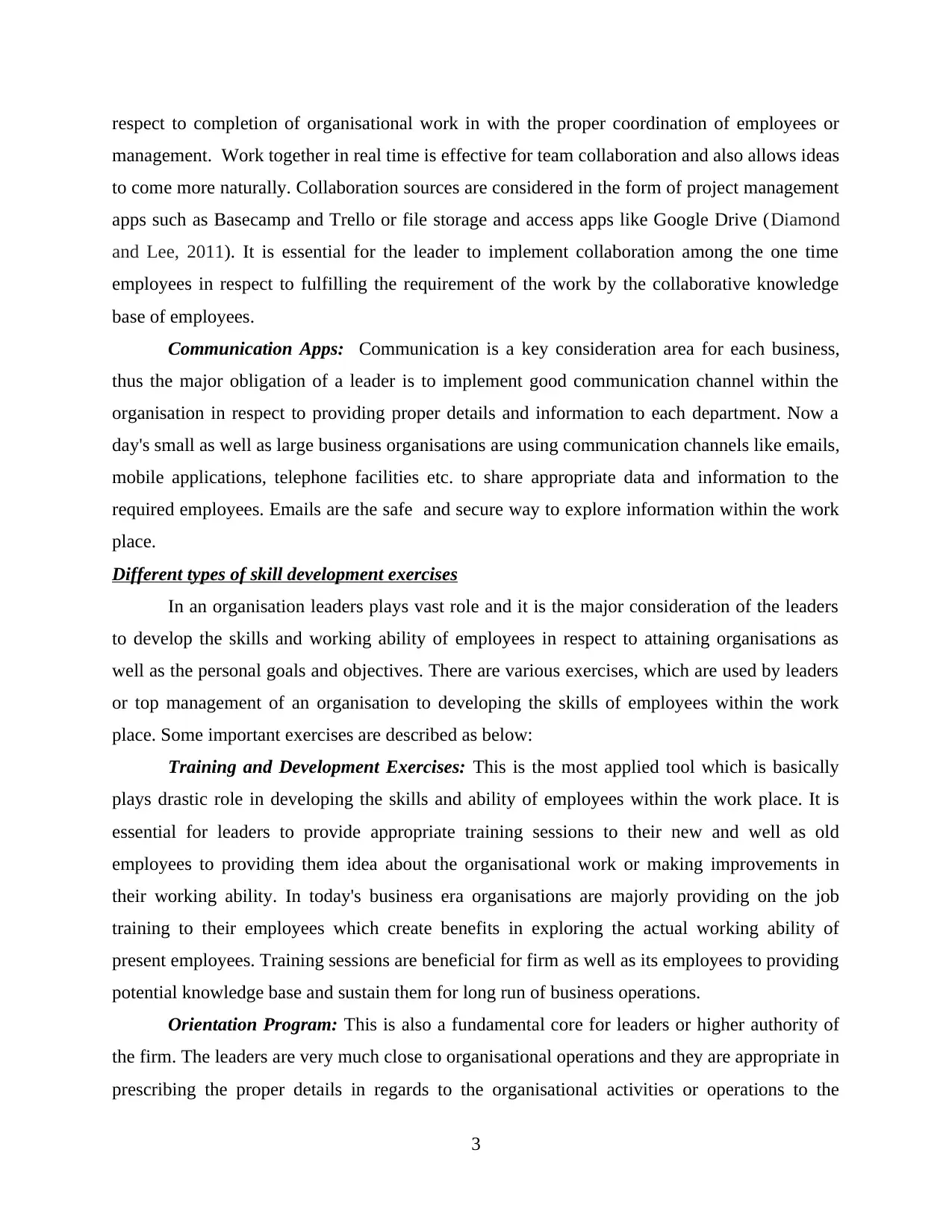
respect to completion of organisational work in with the proper coordination of employees or
management. Work together in real time is effective for team collaboration and also allows ideas
to come more naturally. Collaboration sources are considered in the form of project management
apps such as Basecamp and Trello or file storage and access apps like Google Drive (Diamond
and Lee, 2011). It is essential for the leader to implement collaboration among the one time
employees in respect to fulfilling the requirement of the work by the collaborative knowledge
base of employees.
Communication Apps: Communication is a key consideration area for each business,
thus the major obligation of a leader is to implement good communication channel within the
organisation in respect to providing proper details and information to each department. Now a
day's small as well as large business organisations are using communication channels like emails,
mobile applications, telephone facilities etc. to share appropriate data and information to the
required employees. Emails are the safe and secure way to explore information within the work
place.
Different types of skill development exercises
In an organisation leaders plays vast role and it is the major consideration of the leaders
to develop the skills and working ability of employees in respect to attaining organisations as
well as the personal goals and objectives. There are various exercises, which are used by leaders
or top management of an organisation to developing the skills of employees within the work
place. Some important exercises are described as below:
Training and Development Exercises: This is the most applied tool which is basically
plays drastic role in developing the skills and ability of employees within the work place. It is
essential for leaders to provide appropriate training sessions to their new and well as old
employees to providing them idea about the organisational work or making improvements in
their working ability. In today's business era organisations are majorly providing on the job
training to their employees which create benefits in exploring the actual working ability of
present employees. Training sessions are beneficial for firm as well as its employees to providing
potential knowledge base and sustain them for long run of business operations.
Orientation Program: This is also a fundamental core for leaders or higher authority of
the firm. The leaders are very much close to organisational operations and they are appropriate in
prescribing the proper details in regards to the organisational activities or operations to the
3
management. Work together in real time is effective for team collaboration and also allows ideas
to come more naturally. Collaboration sources are considered in the form of project management
apps such as Basecamp and Trello or file storage and access apps like Google Drive (Diamond
and Lee, 2011). It is essential for the leader to implement collaboration among the one time
employees in respect to fulfilling the requirement of the work by the collaborative knowledge
base of employees.
Communication Apps: Communication is a key consideration area for each business,
thus the major obligation of a leader is to implement good communication channel within the
organisation in respect to providing proper details and information to each department. Now a
day's small as well as large business organisations are using communication channels like emails,
mobile applications, telephone facilities etc. to share appropriate data and information to the
required employees. Emails are the safe and secure way to explore information within the work
place.
Different types of skill development exercises
In an organisation leaders plays vast role and it is the major consideration of the leaders
to develop the skills and working ability of employees in respect to attaining organisations as
well as the personal goals and objectives. There are various exercises, which are used by leaders
or top management of an organisation to developing the skills of employees within the work
place. Some important exercises are described as below:
Training and Development Exercises: This is the most applied tool which is basically
plays drastic role in developing the skills and ability of employees within the work place. It is
essential for leaders to provide appropriate training sessions to their new and well as old
employees to providing them idea about the organisational work or making improvements in
their working ability. In today's business era organisations are majorly providing on the job
training to their employees which create benefits in exploring the actual working ability of
present employees. Training sessions are beneficial for firm as well as its employees to providing
potential knowledge base and sustain them for long run of business operations.
Orientation Program: This is also a fundamental core for leaders or higher authority of
the firm. The leaders are very much close to organisational operations and they are appropriate in
prescribing the proper details in regards to the organisational activities or operations to the
3
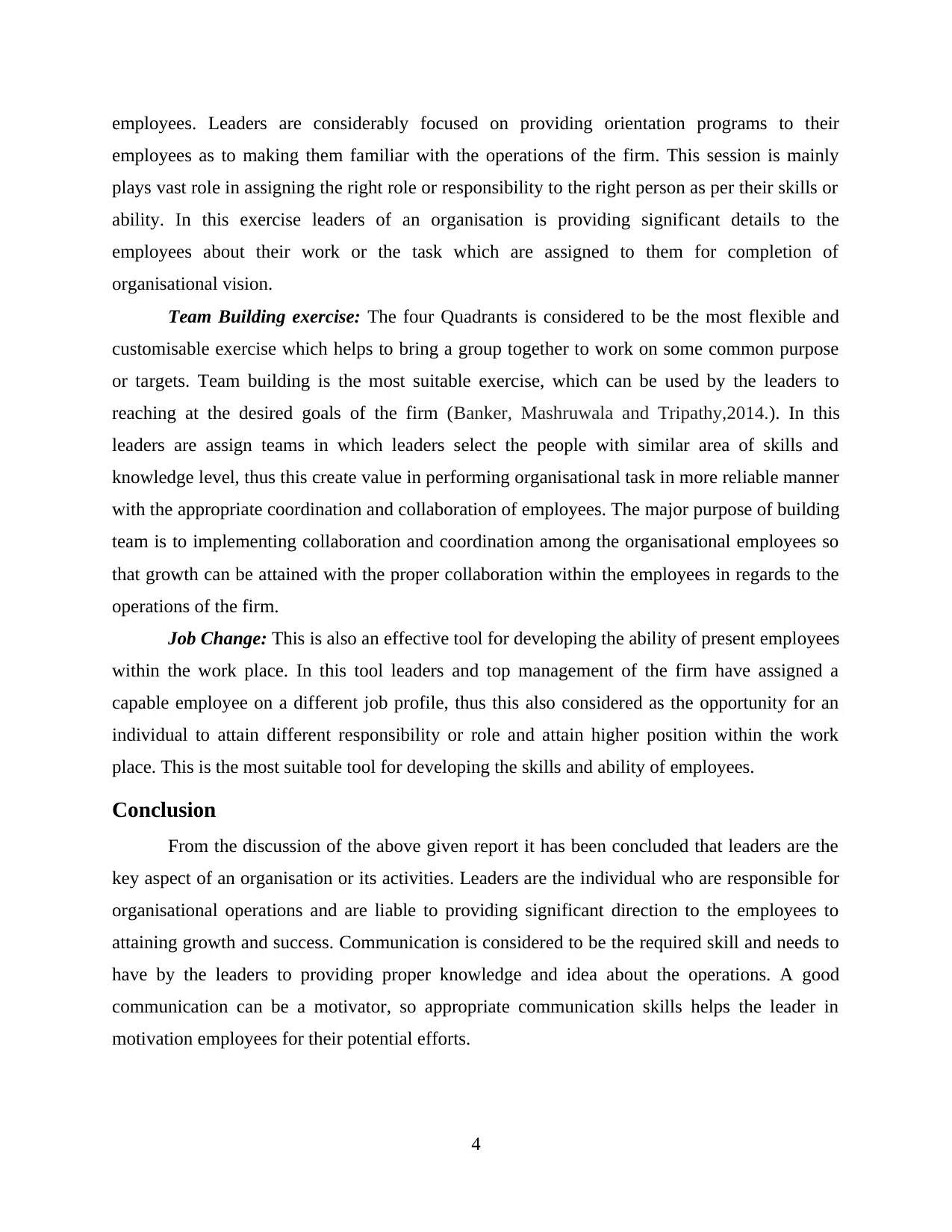
employees. Leaders are considerably focused on providing orientation programs to their
employees as to making them familiar with the operations of the firm. This session is mainly
plays vast role in assigning the right role or responsibility to the right person as per their skills or
ability. In this exercise leaders of an organisation is providing significant details to the
employees about their work or the task which are assigned to them for completion of
organisational vision.
Team Building exercise: The four Quadrants is considered to be the most flexible and
customisable exercise which helps to bring a group together to work on some common purpose
or targets. Team building is the most suitable exercise, which can be used by the leaders to
reaching at the desired goals of the firm (Banker, Mashruwala and Tripathy,2014.). In this
leaders are assign teams in which leaders select the people with similar area of skills and
knowledge level, thus this create value in performing organisational task in more reliable manner
with the appropriate coordination and collaboration of employees. The major purpose of building
team is to implementing collaboration and coordination among the organisational employees so
that growth can be attained with the proper collaboration within the employees in regards to the
operations of the firm.
Job Change: This is also an effective tool for developing the ability of present employees
within the work place. In this tool leaders and top management of the firm have assigned a
capable employee on a different job profile, thus this also considered as the opportunity for an
individual to attain different responsibility or role and attain higher position within the work
place. This is the most suitable tool for developing the skills and ability of employees.
Conclusion
From the discussion of the above given report it has been concluded that leaders are the
key aspect of an organisation or its activities. Leaders are the individual who are responsible for
organisational operations and are liable to providing significant direction to the employees to
attaining growth and success. Communication is considered to be the required skill and needs to
have by the leaders to providing proper knowledge and idea about the operations. A good
communication can be a motivator, so appropriate communication skills helps the leader in
motivation employees for their potential efforts.
4
employees as to making them familiar with the operations of the firm. This session is mainly
plays vast role in assigning the right role or responsibility to the right person as per their skills or
ability. In this exercise leaders of an organisation is providing significant details to the
employees about their work or the task which are assigned to them for completion of
organisational vision.
Team Building exercise: The four Quadrants is considered to be the most flexible and
customisable exercise which helps to bring a group together to work on some common purpose
or targets. Team building is the most suitable exercise, which can be used by the leaders to
reaching at the desired goals of the firm (Banker, Mashruwala and Tripathy,2014.). In this
leaders are assign teams in which leaders select the people with similar area of skills and
knowledge level, thus this create value in performing organisational task in more reliable manner
with the appropriate coordination and collaboration of employees. The major purpose of building
team is to implementing collaboration and coordination among the organisational employees so
that growth can be attained with the proper collaboration within the employees in regards to the
operations of the firm.
Job Change: This is also an effective tool for developing the ability of present employees
within the work place. In this tool leaders and top management of the firm have assigned a
capable employee on a different job profile, thus this also considered as the opportunity for an
individual to attain different responsibility or role and attain higher position within the work
place. This is the most suitable tool for developing the skills and ability of employees.
Conclusion
From the discussion of the above given report it has been concluded that leaders are the
key aspect of an organisation or its activities. Leaders are the individual who are responsible for
organisational operations and are liable to providing significant direction to the employees to
attaining growth and success. Communication is considered to be the required skill and needs to
have by the leaders to providing proper knowledge and idea about the operations. A good
communication can be a motivator, so appropriate communication skills helps the leader in
motivation employees for their potential efforts.
4
⊘ This is a preview!⊘
Do you want full access?
Subscribe today to unlock all pages.

Trusted by 1+ million students worldwide
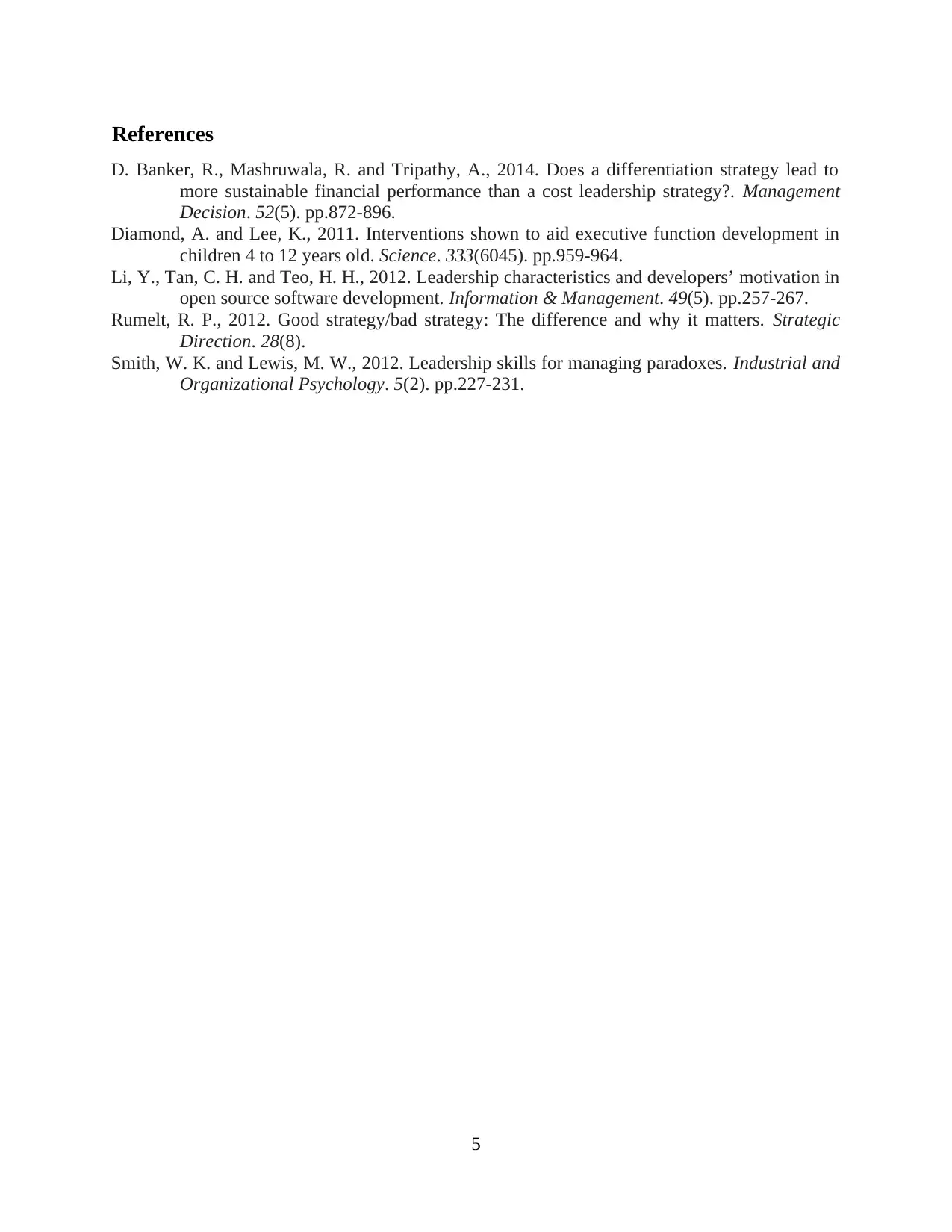
References
D. Banker, R., Mashruwala, R. and Tripathy, A., 2014. Does a differentiation strategy lead to
more sustainable financial performance than a cost leadership strategy?. Management
Decision. 52(5). pp.872-896.
Diamond, A. and Lee, K., 2011. Interventions shown to aid executive function development in
children 4 to 12 years old. Science. 333(6045). pp.959-964.
Li, Y., Tan, C. H. and Teo, H. H., 2012. Leadership characteristics and developers’ motivation in
open source software development. Information & Management. 49(5). pp.257-267.
Rumelt, R. P., 2012. Good strategy/bad strategy: The difference and why it matters. Strategic
Direction. 28(8).
Smith, W. K. and Lewis, M. W., 2012. Leadership skills for managing paradoxes. Industrial and
Organizational Psychology. 5(2). pp.227-231.
5
D. Banker, R., Mashruwala, R. and Tripathy, A., 2014. Does a differentiation strategy lead to
more sustainable financial performance than a cost leadership strategy?. Management
Decision. 52(5). pp.872-896.
Diamond, A. and Lee, K., 2011. Interventions shown to aid executive function development in
children 4 to 12 years old. Science. 333(6045). pp.959-964.
Li, Y., Tan, C. H. and Teo, H. H., 2012. Leadership characteristics and developers’ motivation in
open source software development. Information & Management. 49(5). pp.257-267.
Rumelt, R. P., 2012. Good strategy/bad strategy: The difference and why it matters. Strategic
Direction. 28(8).
Smith, W. K. and Lewis, M. W., 2012. Leadership skills for managing paradoxes. Industrial and
Organizational Psychology. 5(2). pp.227-231.
5
1 out of 7
Related Documents
Your All-in-One AI-Powered Toolkit for Academic Success.
+13062052269
info@desklib.com
Available 24*7 on WhatsApp / Email
![[object Object]](/_next/static/media/star-bottom.7253800d.svg)
Unlock your academic potential
Copyright © 2020–2025 A2Z Services. All Rights Reserved. Developed and managed by ZUCOL.





